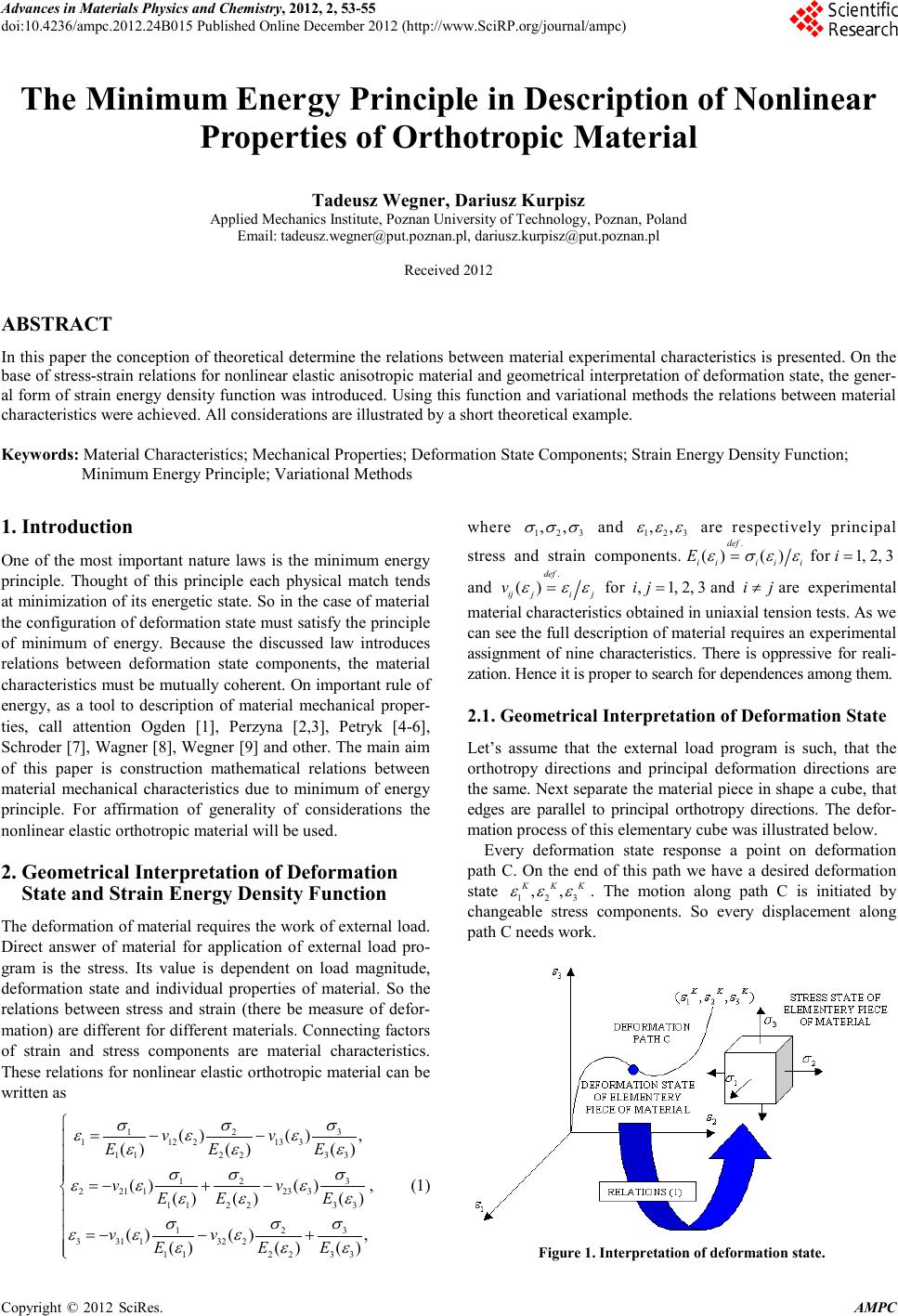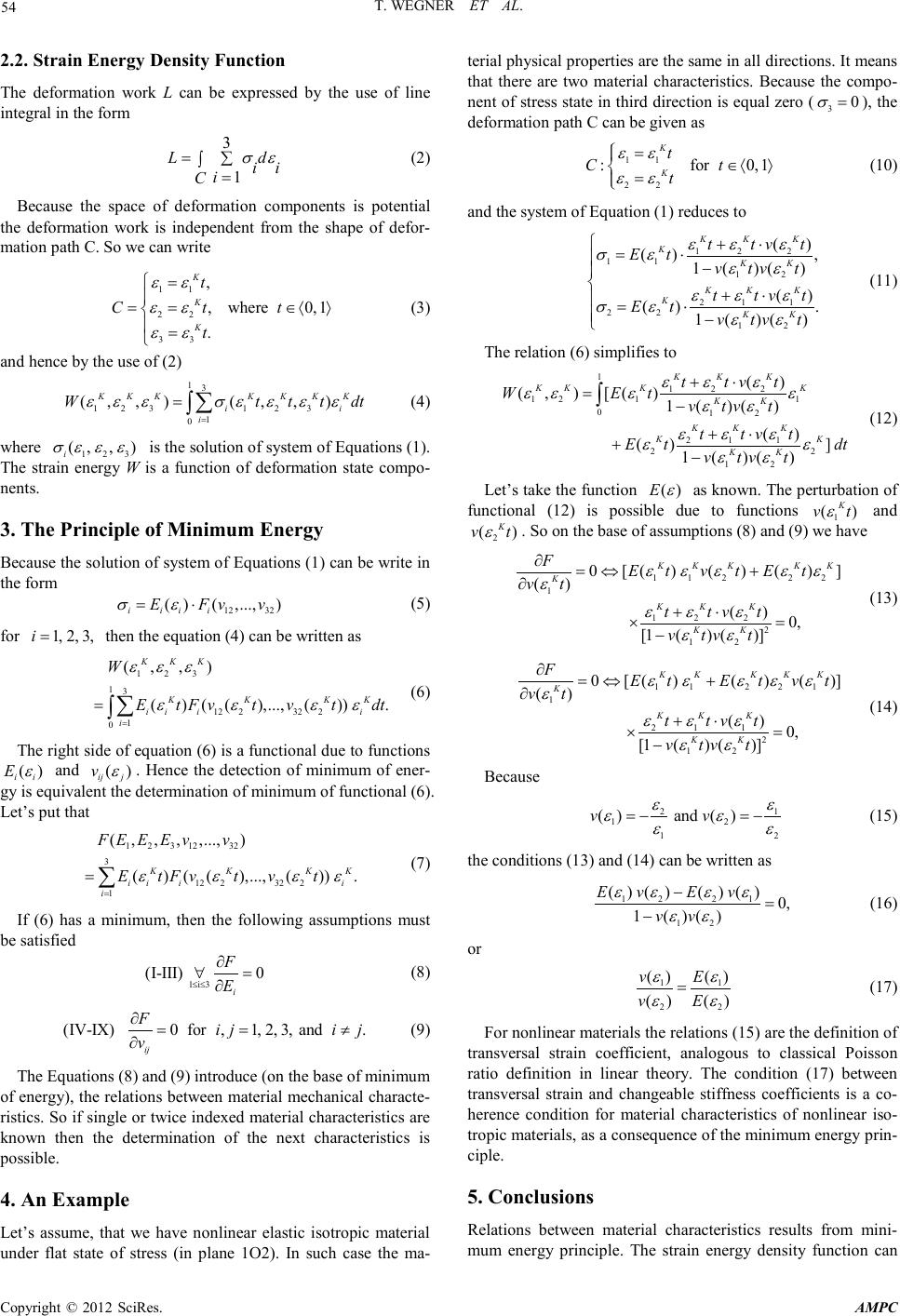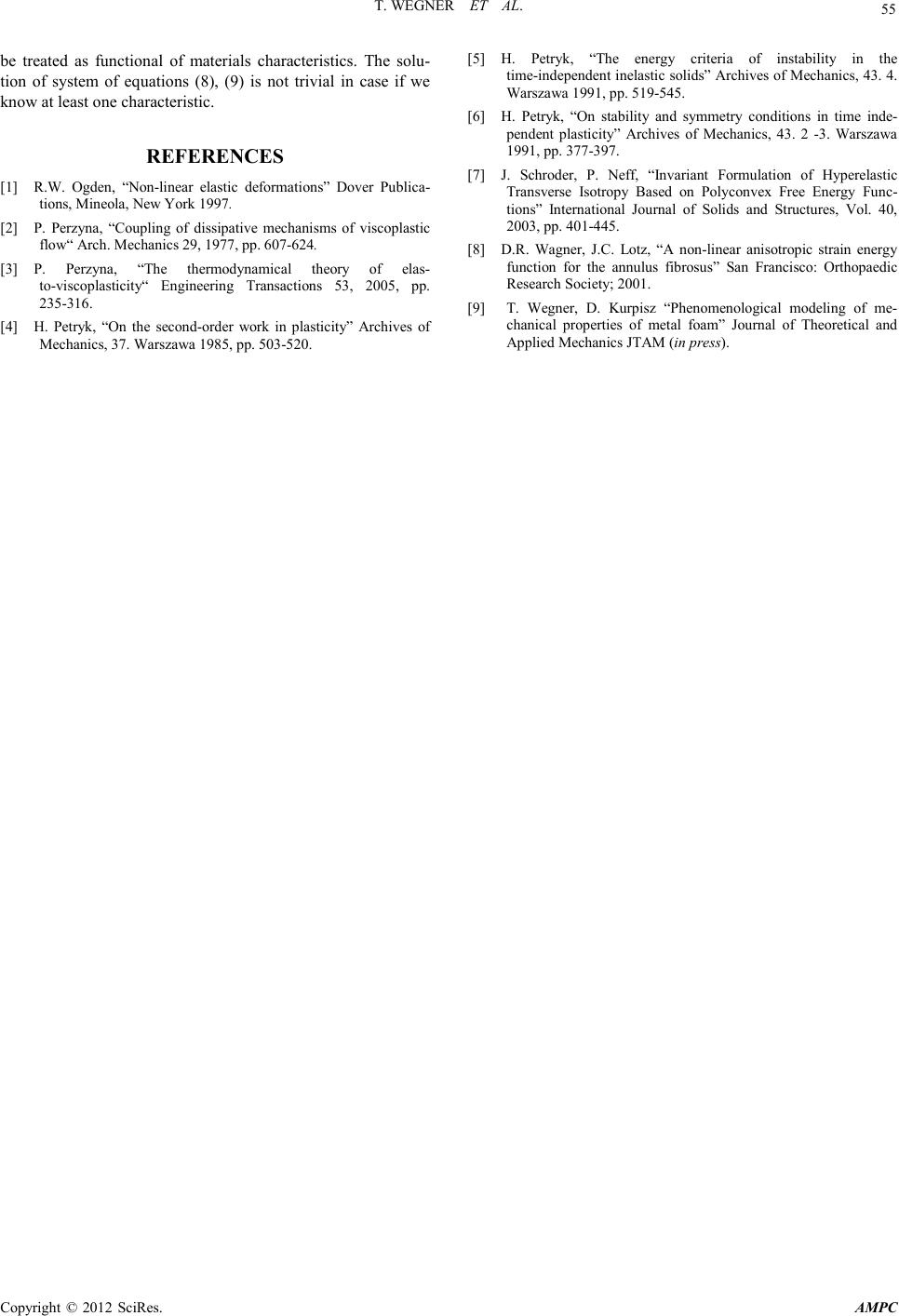Paper Menu >>
Journal Menu >>
 Advances in Ma terials Physics and Che mist ry, 2012, 2, 53-55 doi:10.4236/ampc.2012.24B015 Published Online December 2012 (htt p://www.Sc iRP.org/journal/ampc) Copyright © 2012 SciRes. AM PC The Minimum Energy Principle in Description of Nonlinear Properties of Orthotropic Material Tadeusz Wegner, Dariusz Kur pisz Applied Mechanics Institute, Poznan University of Technology, Poznan, Poland Email: tadeusz.wegner@put.poznan.pl, dariusz.kurpisz@put.poznan.pl Received 2012 ABSTRACT In th is paper the con ception o f theoretical d etermine the relat ions b etween material experiment al characteris tics is presen ted. On the base of stres s-strain relatio ns for nonlin ear elasti c anisotrop ic material an d geometrical interpretation of deformation state, the gener- al form of strain energy density function was introduced. Using this function and variational methods the relations between material characteristics were achieved. All consi derations are illus trated by a short th eoretical example. Keywords: Material C haracteri s tics; Mechanical Propert ies; Deformati on S tate Compon ents; Strain Energy Densit y Fu nction ; Minimum Energy Principle; Variational Methods 1. Introduction One of the most important nature laws is the minimum energy principle. Thought of this principle each physical match tends at mini mizati on of its en ergetic state. So in the case of material the configuration of deformation state must satisfy the principle of minimum of energy. Because the discussed law introduces relations between deformation state components, the material characteri stics must b e mutually coh erent. On i mpo rtant rule of energy, as a tool to description of material mechanical proper- ties, call attention Ogden [1], Perzyna [2,3], Petryk [4-6], Schrod er [7], Wagner [ 8], Wegner [ 9] and other. The main aim of this paper is construction mathematical relations between material mechanical characteristics due to minimum of energy principle. For affirmation of generality of considerations the nonlinear elastic orthotropic material will be used. 2. Geometrical Interpretation of Deformation State and Strain Energy Density Function The deformation of material requires the work of external load. Direct answer of material for application of external load pro- gram is the stress. Its value is dependent on load magnitude, deformation state and individual properties of material. So the relations between stress and strain (there be measure of defor- mation ) are different for d ifferent mat erials. Co nnectin g factors of strain and stress components are material characteristics. These relati ons for nonli near elastic orth otropic material can b e written as 123 112213 3 112 233 12 3 221 1233 112 233 1 23 3311322 112 233 ()() , ()() () ()() , () ()() () (), ()() () vv EEE vv EE E vv E EE σσσ ε εε εεε σσ σ εε ε εε ε σ σσ εε ε ε εε =−− =− +− =−− + (1) where 123 ,, σσσ and 123 ,, εεε are respectively principal stress and strain components. . () () def iiii i E εσε ε = for 1,2, 3i= and . () def ij jij v ε εε = for ,1,2, 3ij= and ij≠ are experimental material character istics obtained in u niaxial tension tests. As we can see th e full descrip tion of materi al requ ires an experimental assignment of nine characteristics. There is oppressive for reali- zation. Hence it is proper to search for dependences among t hem. 2.1. Geometrical Interpretation of Deformation State Let’s assume that the external load program is such, that the orthotropy directions and principal deformation directions are the same. Next separate the mat erial p iece in shape a cube, that edges are parallel to principal orthotropy directions. The defor- mation process of this el ement ary cube was illustrated belo w. Every deformation state response a point on deformation path C. On the end of this path we have a desired deformation state 123 ,, KKK εεε . The motion along path C is initiated by changeable stress components. So every displacement along path C needs work. Figure 1. Interpretation of def ormation state .  T. WEGNER ET AL. Copyright © 2012 SciRes. AMPC 54 2.2. Strain Energy Density Funct ion The deformation work L can be expressed by the use of line integral in the form 3 1 Ld ii i C σε =∑ ∫= (2) Because the space of deformation components is potential the deformation work is independent from the shape of defor- mation path C. So we can write 11 22 33 , ,where 0,1 . K K K t C tt t εε εε εε = ==∈〈 〉 = (3) and hence by the use of (2) 13 12312 3 1 0 (, , )(,,) KKKKKK K ii i Wttt dt ε εεσεεεε = = ∑ ∫ (4) where 123 (, , ) i σεε ε is the solution of system of Equations (1). The strain energy W is a function of deformation state compo- nents. 3. The Principle of Minimum Energy Because th e solution of system of Equations (1) can be write in the form 12 32 ( )(,...,) iii i EFv v σε = ⋅ (5) for 1,2, 3,i= then the equation (4) can be written as 123 13 12 232 2 1 0 (,,) ()(( ),...,( )). KKK K KKK ii ii i W Et Fvtvtdt εεε ε εεε = =∑ ∫ (6) The right side of equation (6) is a functional due to functions () ii E ε and () ij j v ε . Hence the detection of minimum of ener- gy is equivalent the determination of minimum of functional (6). Let’s put that 123 1232 3 12 232 2 1 (,,,,...,) ()(( ),...,( )). K KKK ii ii i FE EE vv E tFvt vt ε εεε = =∑ (7) If (6) has a minimum, then the following assumptions must be satisfied 1i3 (I-III) 0 i F E ≤≤ ∂ ∀= ∂ (8) (IV-IX) 0 for ,1,2,3, and . ij Fiji j v ∂= =≠ ∂ (9) The Equations (8) and (9) introduce (on the base of minimum of energ y), t he relatio ns between materi al mechanical characte- ristics. So if single or twice indexed material characteristics are known then the determination of the next characteristics is possible. 4. An Example Let’s assume, that we have nonlinear elastic isotropic material under flat state of stress (in plane 1O2). In such case the ma- terial ph ysical p rop ert ies are t he same in all d ir ection s. It means that there are two material characteristics. Because the compo- nent of stress state in third direction is equal zero ( 30 σ = ), th e deformation path C can be given as 11 22 :for 0,1 K K t Ct t εε εε = ∈〈 〉 = (10) and the system of Equation (1) reduces to 12 2 11 12 21 1 22 12 () () , 1 ()() () () . 1 ()() KK K K KK KK K K KK ttv t Et v tvt ttv t Et v tvt εε ε σε εε εε ε σε εε +⋅ = ⋅ − +⋅ = ⋅ − (11) The relation (6) simplifies to 112 2 12 11 012 21 1 22 12 () ( ,)[() 1 ()() () ()] 1 ()() KK K KK KK KK KK K KK KK ttv t WEt v tvt ttvt E tdt v tvt εε ε εε εε εε εε ε εε εε +⋅ =− +⋅ +− ∫ (12) Let’s take the function ()E ε as known. The perturbation of functional (12) is possible due to functions 1 () K vt ε and 2 () K vt ε . So on the base of assumptions (8) and (9) we have 1 1222 1 12 2 2 12 0[() ()()] () () 0, [1() ()] K K KKK K KK K KK FE tvtEt vt ttv t v tvt εεε εε ε εε ε εε ∂=⇔+ ∂ +⋅ ×= − (13) 1 1221 1 21 1 2 12 0[()() ()] () () 0, [1() ()] K KKKK K KK K KK FEt Etvt vt ttv t v tvt εεεε ε ε εε ε εε ∂=⇔+ ∂ +⋅ ×= − (14) Because 21 12 12 () and ()vv εε εε εε =−=− (15) the conditions (13) and (14) can be written as 12 21 12 ()( )( )()0, 1( )() Ev Ev vv εε εε εε −= − (16) or 11 22 () () () () vE vE εε εε = (17) For nonlinear materials the relations (15) are the definition of transversal strain coefficient, analogous to classical Poisson ratio definition in linear theory. The condition (17) between transversal strain and changeable stiffness coefficients is a co- herence condition for material characteristics of nonlinear iso- trop ic material s, as a co nseq u ence o f the minimum energ y p rin- ciple. 5. Conclusions Relations between material characteristics results from mini- mum energy principle. The strain energy density function can  T. WEGNER ET AL. Copyright © 2012 SciRes. AM PC 55 be treated as functional of materials characteristics. The solu- tion of system of equations (8), (9) is not trivial in case if we know at least one ch ar acteristi c. REFERENCES [1] R.W. Ogden, “Non-linear elastic deformations” Dover Publica- tions, Mineola, New Yor k 1997. [2] P. Perzyna, “Coupling of dissipative mechanisms of viscoplastic flow“ Arch. Mechanics 29, 1977, pp. 607-624. [3] P. Perzyna, “The thermodynamical theory of elas- to-viscoplasticity“ Engineering Transactions 53, 2005, pp. 235-316. [4] H. Petryk, “On the second-order work in plasticity” Archives of Mechanics, 37. W ar szawa 1985, pp . 5 03-520. [5] H. Petryk, “The energy criteria of instability in the time-independent inelastic solids” Archives of Mechanics, 43. 4. Warszawa 1991, pp. 519-545. [6] H. Petryk, “On stability and symmetry conditions in time inde- pendent plasticity” Archives of Mechanics, 43. 2 -3. Warszawa 1991, pp. 377-397. [7] J. Schroder, P. Neff, “Invariant Formulation of Hyperelastic Transverse Isotropy Based on Polyconvex Free Energy Func- tions” International Journal of Solids and Structures, Vol. 40, 2003, pp. 401-445. [8] D.R. Wagner, J.C. Lotz, “A non-linear anisotropic strain energy function for the annulus fibrosus” San Francisco: Orthopaedic Research Society; 2001. [9] T. Wegner, D. Kurpisz “Phenomenological modeling of me- chanical properties of metal foam” Journal of Theoretical and Applied Mechanics JTAM (in press). |

